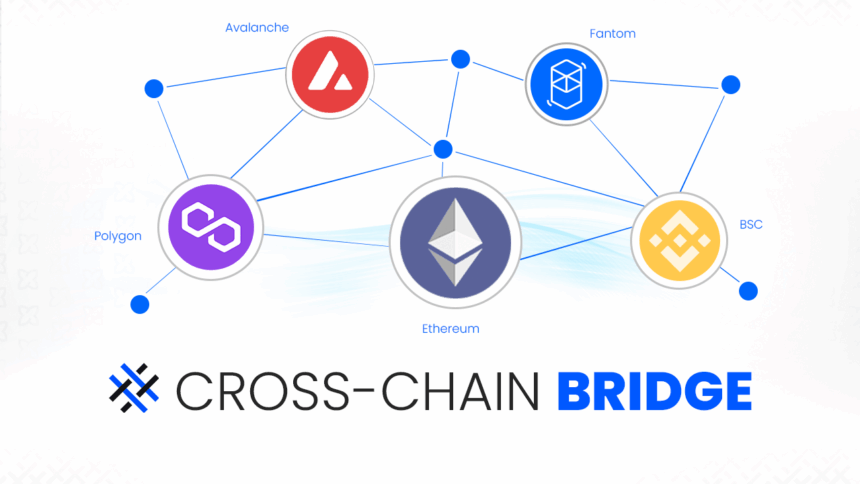This article will look at the Top Cross-Chain Bridging Protocols for NFTs. I will look at protocols that allow for easy and seamless NFT transfers across different blockchains.
These protocols allow for the increasing interoperability, liquidity, and security of digital assets. It allows NFT market places, GameFi platforms, and NFT collectors facilitate and trade NFTs effortlessly. These top bridges must be understood by anyone looking to engage with the multi-chain NFT market.
What is Cross-Chain Bridging Protocols?
Cross-chain bridging protocols provide the transfer of NFTs and other cryptocurrencies across blockchain networks. Blockchains are isolated ecosystems and tokens cannot flow freely across different chains.
Cross-chain bridges provide a seamless way of locking assets and tokens on the source chain so that they can minted or freed on the chosen destination chain. The expanded inter-chain access and liquidity diffuse growth in DeFi and GameFi ecosystems and seamless liquidity in multi-chain scenarios.
How To Choose Top Cross-Chain Bridging Protocols for NFTs
Security & Audits: Check if the system has a good security record, transfers safely, and regularly audits so transfers won’t get hacked and NFTs won’t get lost.
Supported Blockchains: Determine if the bridge supports the blockchains on which your NFTs exist for easy transfers.
Transaction Speed & Fees: Review and compare the relative speed and cost of transactions to make sure they won’t hinder profitability or efficiency.
User Experience: An intuitive system for cross-chain transfers, especially for novices, indicates a good level of service.
Liquidity & Reliability: Choose bridges that won’t slacken on transfers or cause transfers to fail.
Key Point & Top Cross-Chain Bridging Protocols for NFTs List
| Protocol | Key Points |
|---|---|
| LayerZero | Omnichain interoperability, lightweight messaging, high security for NFTs. |
| Wormhole | Multi-chain support, fast transfers, widely used in NFT and DeFi ecosystems. |
| Celer cBridge | Low fees, fast cross-chain transactions, user-friendly interface. |
| zkBridge | Zero-knowledge proof security, privacy-focused, scalable bridging solution. |
| Portal Bridge | NFT-focused, reliable transfers, seamless user experience. |
| Allbridge | Supports multiple chains, easy integration, high liquidity. |
| Axelar Network | Decentralized routing, strong security, multi-chain communication. |
| Router Protocol | Cross-chain asset movement, DeFi & NFT integration, secure bridge design. |
| ChainPort | Enterprise-ready, NFT & token support, scalable and secure transfers. |
1. LayerZero
LayerZero is among the best cross-chain bridging protocols for NFTs. It has special omnichain interoperability, which facilitates nascent communication across multiple blockchains without using centralized intermediaries.
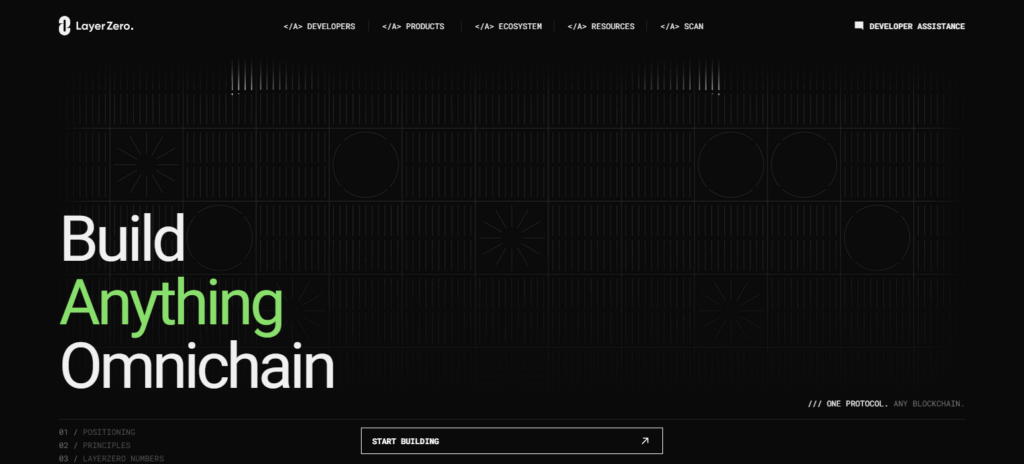
Its lightweight architecture further secures and accelerates transfers, sidestepping potential delays and failures. LayerZero radically departs from traditional bridging design in enabling cross-chain interoperability for developers building applications that enhance trade and cross-chain NFT accessibility.
Because of LayerZero’s low latency, reliability, and security, NFT marketplaces and GameFi ecosystems have become LayerZero’s top use cases while the protocol secures its place as a first-rate cross-chain solution in the rapidly changing multi-chain space.
| Feature | Details |
|---|---|
| Supported Chains | Ethereum, Binance Smart Chain, Polygon, Avalanche, Fantom, and more |
| NFT Compatibility | Yes – supports seamless NFT transfers across multiple chains |
| KYC Requirements | Minimal – primarily wallet-based authentication |
| Transaction Speed | Fast – near-instant cross-chain transfers |
| Security | Decentralized messaging protocol, audited smart contracts, secure bridging |
| Fees | Low to moderate – varies by network |
| User Experience | Intuitive interface for developers and users |
| Use Cases | NFT marketplaces, GameFi platforms, multi-chain asset transfers |
2. Wormhole
Wormhole has established itself as a premier cross-chain bridging protocol for NFTs due to its extensive multi-chain offers coupled with quick and dependably safe transfers.
Its best feature is pairing the Ethereum, Solana, and Binance Smart Chain blockchains and letting NFTs circulate freely in all ecosystems.
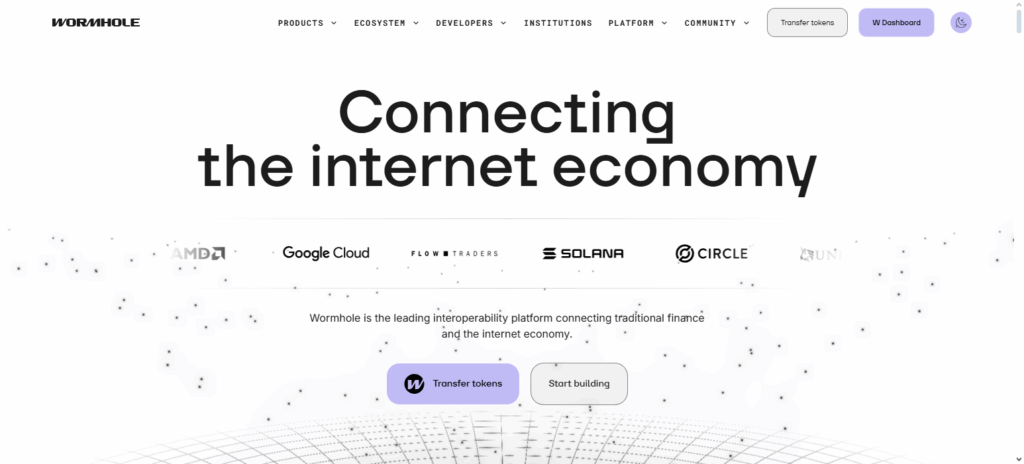
Wormhole guarantees a safe and provable transfer of assets in a decentralized manner with astonishing efficiency and minimal delays. It accommodates large-scale NFTs and DeFi projects with equal liquidity and cross-chain flexibility.
The combination of these attributes makes Wormhole an ideal selection for a reliable and flexible NFT bridge as Developers and clients value safe, fast, and unhindered cross-chain capabilities.
| Feature | Details |
|---|---|
| Supported Chains | Ethereum, Solana, Binance Smart Chain, Avalanche, Polygon, Terra |
| NFT Compatibility | Yes – seamless NFT transfers across supported blockchains |
| KYC Requirements | Minimal – wallet-based authentication only |
| Transaction Speed | Fast – near real-time cross-chain transfers |
| Security | Decentralized guardians, audited smart contracts, secure bridging |
| Fees | Low to moderate – depends on network congestion |
| User Experience | Simple interface for NFT transfers and developers |
| Use Cases | NFT marketplaces, DeFi, GameFi platforms |
3. Celer cBridge
Celer cBridge is among the best NFT cross-chain bridging options due to its rapid effective cross-chain transaction processing at very competitive prices.
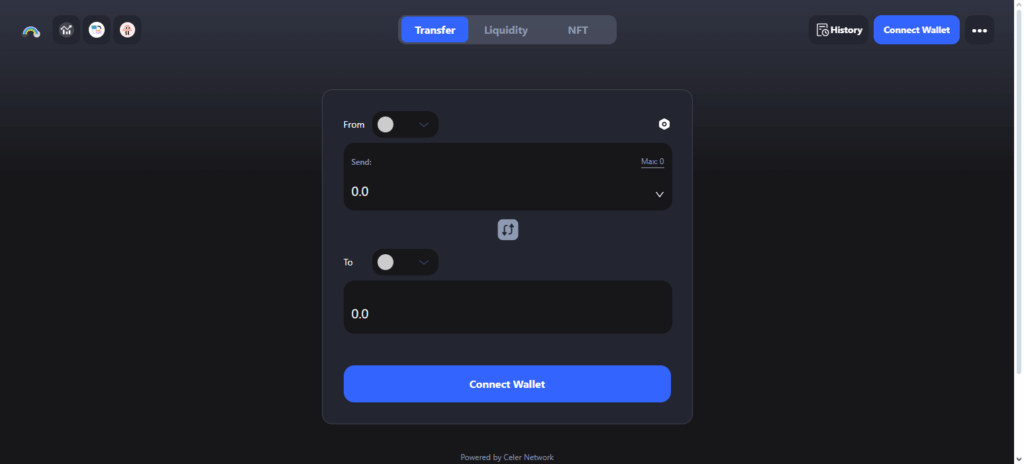
Its specially designed multi-chain system enables the transfer of NFTs and other digital assets over many blockchains, such as Ethereum, Binance Smart Chain, and Polygon. High-speed, low-cost, and secure asset bridging contributes to the popularity of Celer cBridge in the NFT marketplace and GameFi platforms.
Also, the customer experience is plain and uncomplicated, making it possible for users with little or no experience to perform transfers. There is reduced delay due to liquidity bridging. Assets are always secure with enforced strong policies on bridging.
| Feature | Details |
|---|---|
| Supported Chains | Ethereum, Binance Smart Chain, Polygon, Avalanche, Fantom, Arbitrum |
| NFT Compatibility | Yes – supports seamless NFT transfers across multiple chains |
| KYC Requirements | Minimal – wallet-based authentication only |
| Transaction Speed | Very fast – optimized for low-latency cross-chain transfers |
| Security | Decentralized smart contracts, audited protocols, secure bridging |
| Fees | Low – cost-efficient for frequent transfers |
| User Experience | Intuitive interface, easy for both developers and end-users |
| Use Cases | NFT marketplaces, GameFi platforms, DeFi integrations |
4. zkBridge
zkBridge is one of the leading cross-chain protocols for bridging NFTs. It uniquely employs zero-knowledge (zk) proofs for secure and privacy-focused transfers on different blockchains.
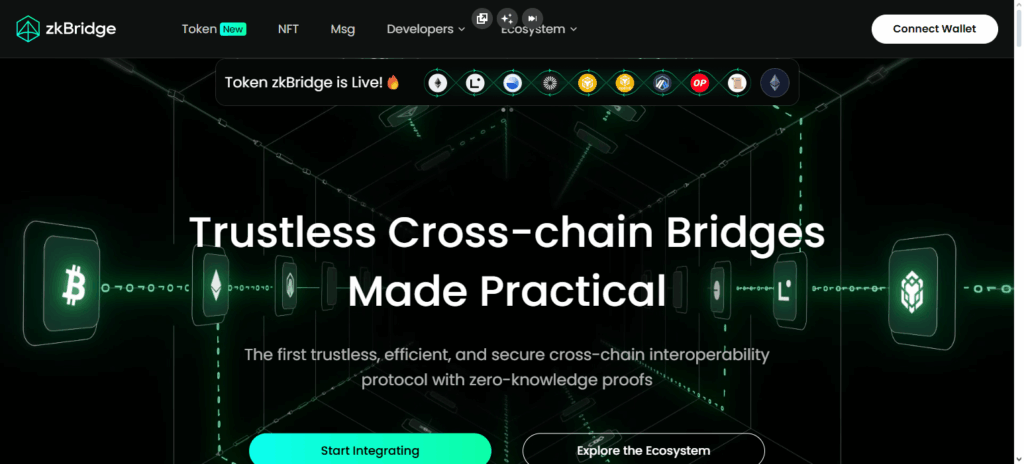
Other bridges reveal sensitive data about the users and NFTs during transfers but zkBridge transaction validation processes keep NFT ownership and transactions protected. Bridging assets with zkBridge is quick and efficient and this helps in reducing congestion and lowering costs because of the scalable architecture.
It works with several blockchains which increases the inter-chain operability of NFTs while keeping decentralized security. With privacy, speed, and multi-chain functionality, zkBridge is ideal for NFT marketplaces and GameFi applications needing secure cross-chain integrations.
| Feature | Details |
|---|---|
| Supported Chains | Ethereum, Polygon, Binance Smart Chain, Avalanche, Fantom |
| NFT Compatibility | Yes – supports secure NFT transfers across multiple chains |
| KYC Requirements | Minimal – wallet-based authentication only |
| Transaction Speed | Fast – efficient zero-knowledge proof-based transfers |
| Security | Zero-knowledge proofs, decentralized validation, secure bridging |
| Fees | Low to moderate – depends on network conditions |
| User Experience | Developer-friendly interface with simplified NFT bridging |
| Use Cases | NFT marketplaces, GameFi platforms, privacy-focused NFT transfers |
5. Portal Bridge
Portal Bridge stands out among cross-chain bridging protocols for its seamless integration and dependable transfers across multiple blockchains.
Unlike most services, Portal Bridge prioritizes NFT cross-chain functionality, making sure digital collectibles have their metadata and authenticity preserved while crossing ecosystems.
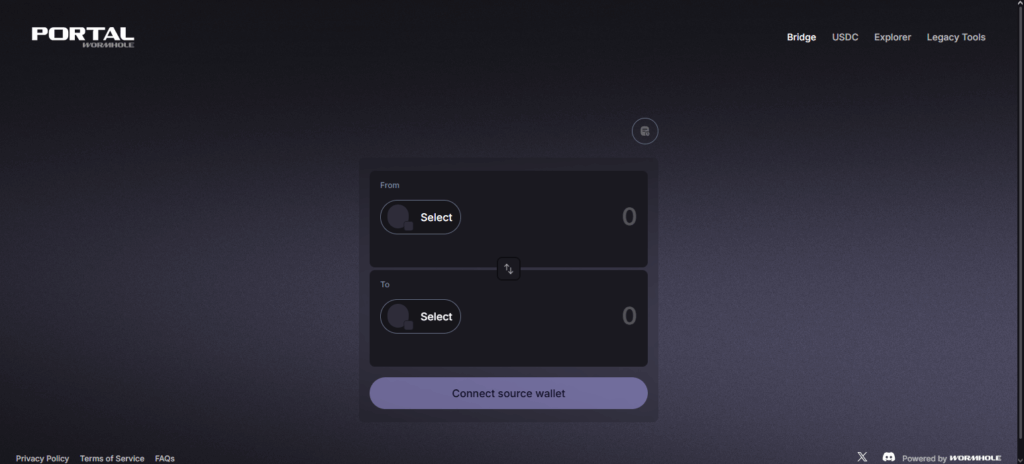
Advanced security protocols and decentralized validation systems allow Portal Bridge to secure assets against hacks and offer protection against transaction failures.
User-centric design and optimized transaction processing minimize delays for creators and patrons. Portal Bridge pioneered multi-chain NFT transactions, expanding the horizon for NFT and GameFi ecosystems, and seamlessly integrated secure, efficient cross-chain services.
| Feature | Details |
|---|---|
| Supported Chains | Ethereum, Binance Smart Chain, Polygon, Avalanche |
| NFT Compatibility | Yes – seamless NFT transfers with metadata preservation |
| KYC Requirements | Minimal – wallet-based authentication only |
| Transaction Speed | Fast – optimized for quick cross-chain NFT transfers |
| Security | Decentralized validation, audited smart contracts, secure bridging |
| Fees | Low to moderate – network-dependent |
| User Experience | Easy-to-use interface for developers and NFT collectors |
| Use Cases | NFT marketplaces, GameFi platforms, multi-chain NFT operations |
6. Allbridge
Allbridge is a premier multi-chain compatible and cross-chain NFT bridging protocol noted for its effortless and wide asset transfer abilities.
What sets Allbridge apart is the diversity of chains it functions with, allowing NFTs to transfer seamlessly between Ethereum, Avalanche, and Solana ecosystems.
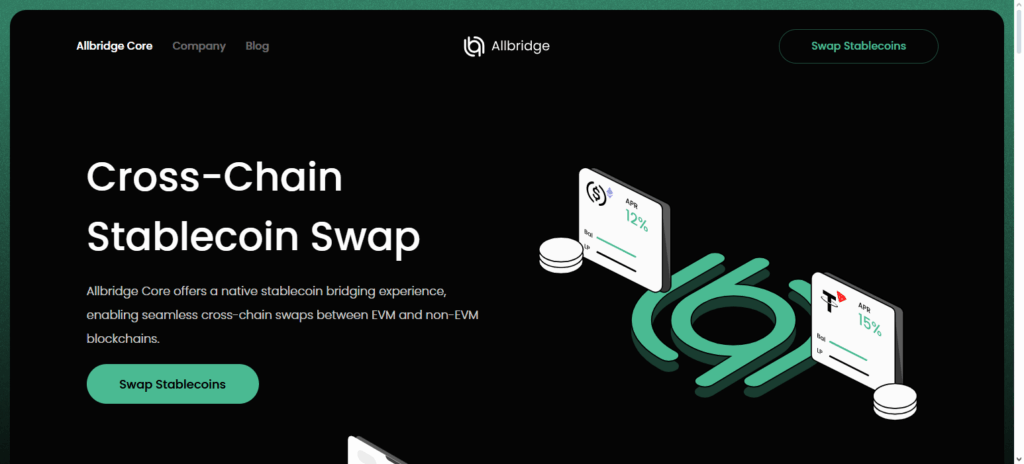
Allbridge guarantees safety with decentralized validators and strong crypto, while ownership and metadata of NFTs remain secure and constant during transfers.
Allbridge’s innovative layered approach to architecture minimizes friction during cross-chain transactions, sustaining low-cost operations. Given the unmatched low latency, safety, and cross-chain interoperability focusing the NFT bridging marketplace and GameFi ecosystems on Allbridge branching connectors became evident.
| Feature | Details |
|---|---|
| Supported Chains | Ethereum, Binance Smart Chain, Polygon, Avalanche, Solana |
| NFT Compatibility | Yes – supports NFT transfers while preserving ownership and metadata |
| KYC Requirements | Minimal – wallet-based authentication only |
| Transaction Speed | Fast – efficient cross-chain transfers |
| Security | Decentralized validation, audited smart contracts, secure bridging |
| Fees | Low to moderate – network-dependent |
| User Experience | User-friendly interface for NFT transfers and developers |
| Use Cases | NFT marketplaces, GameFi platforms, multi-chain NFT integrations |
7. Axelar Network
Axelar Network is an industry-leading cross-chain bridging protocol for NFTs. It has gained this reputation for its decentralized routing system that is able to facilitate trustworthy and frictionless transfers of information between numerous blockchains. It operates cross chains seamlessly and ethically.
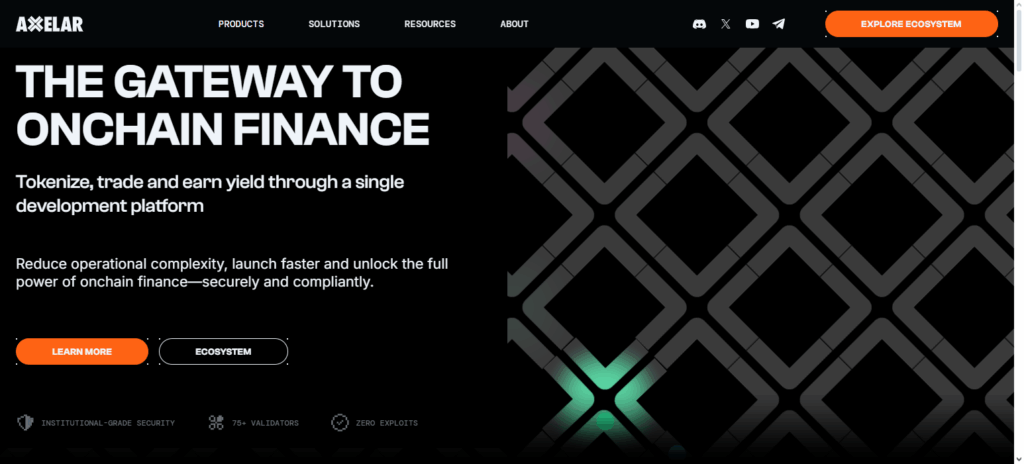
Axelar is able to make NFTs shift between blockchains without needing convoluted cross-chain setups or third-party brokers. Axelar has high reliability and low latency which results in swift and successful transfers and fraud and hack security.
Axelar Network increases JWT liquidity and availability by supporting many blockchains and interoperability. Outstanding security, rapid transfers and simple cross-chain operations make Axelar Network a top choice for NFT markets and GameFi applications.
| Feature | Details |
|---|---|
| Supported Chains | Ethereum, Binance Smart Chain, Polygon, Avalanche, Fantom, Solana |
| NFT Compatibility | Yes – supports seamless NFT transfers across multiple blockchains |
| KYC Requirements | Minimal – wallet-based authentication only |
| Transaction Speed | Fast – low-latency cross-chain transfers |
| Security | Decentralized routing, audited smart contracts, secure bridging |
| Fees | Low to moderate – depends on network conditions |
| User Experience | Simple interface for developers and users |
| Use Cases | NFT marketplaces, GameFi platforms, multi-chain NFT operations |
8. Router Protocol
Router Protocol is a leader in cross-chain bridging for NFTs. It is highly influenced for providing secure and seamless transfers for multi-chain NFTs. It’s strategic advantage is aggregating liquidity across several chains.
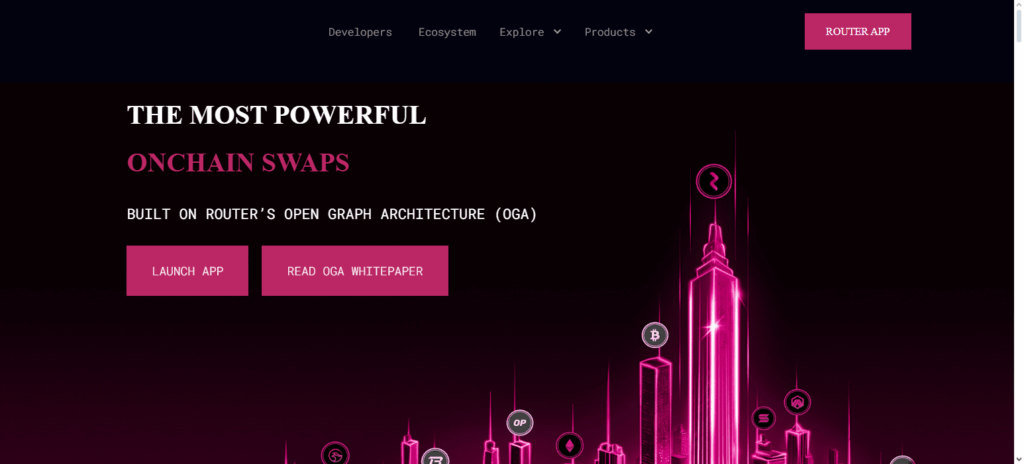
This allows for NFTs to be transferred or swapped without delays and excessive fees. Crossing/Inter-changing blockchains is important for NFT marketplace and crypto gaming Router Protocol places great emphasis on security with the primary use of decentralized validation and strong encryption for NFTs in transfers.
With the most dependable level of speed and cross-chain operational flexibility, Router Protocol is highly regarded to assist developers and clients in executing and multi-chain NFT transactions seamlessly.
| Feature | Details |
|---|---|
| Supported Chains | Ethereum, Binance Smart Chain, Polygon, Avalanche, Fantom, Arbitrum |
| NFT Compatibility | Yes – supports secure and seamless NFT transfers across multiple chains |
| KYC Requirements | Minimal – wallet-based authentication only |
| Transaction Speed | Fast – optimized for low-latency cross-chain transfers |
| Security | Decentralized validation, audited smart contracts, secure bridging |
| Fees | Low – cost-effective for frequent NFT transfers |
| User Experience | Intuitive interface suitable for developers and collectors |
| Use Cases | NFT marketplaces, GameFi platforms, multi-chain NFT operations |
9. ChainPort
ChainPort is a leading cross-chain bridging protocol for enterprise-ready Infrastructure for secure, scalable, and efficient transfer of digital assets for cross multiple chains.
The value proposition is supporting NFTs and Tokens while retaining ownership, provenance and metadata across chains.
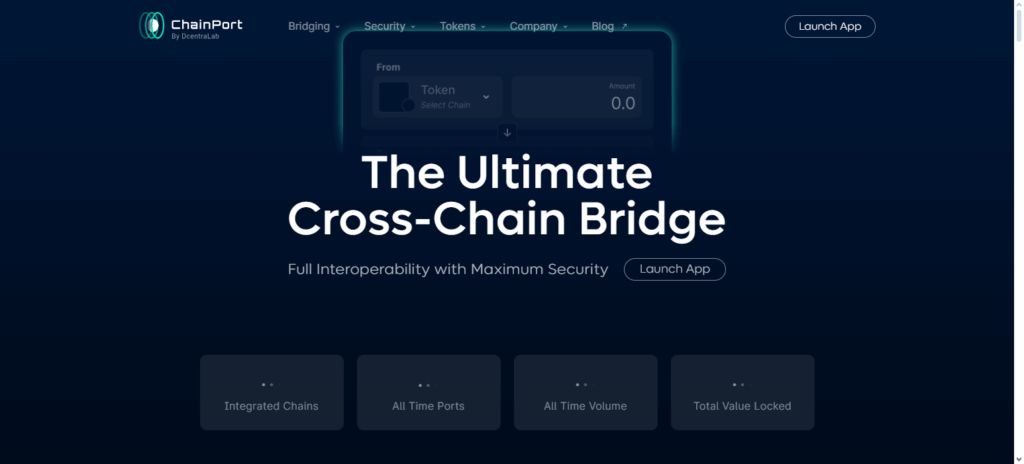
Lowering security risks of hacks or transaction failures ChainPort combines decentralized validation, cutting-edge encryption, and fast transaction processing. Integrated cross-chain compatibility minimizes transaction costs and opens unlimited possibilities for expansion to GameFi projects, NFT marketplaces and creators.
ChainPort is a top choice for cross-chain bridges where interoperability is focused on NFTs, owing to its unrivaled combination of dependability, adaptability, and target NFT capabilities.
| Feature | Details |
|---|---|
| Supported Chains | Ethereum, Binance Smart Chain, Polygon, Avalanche, Solana |
| NFT Compatibility | Yes – supports NFT transfers with metadata and ownership preservation |
| KYC Requirements | Minimal – wallet-based authentication only |
| Transaction Speed | Fast – efficient and reliable cross-chain transfers |
| Security | Decentralized validation, audited smart contracts, secure bridging |
| Fees | Low to moderate – network-dependent |
| User Experience | User-friendly interface for developers and NFT collectors |
| Use Cases | NFT marketplaces, GameFi platforms, multi-chain NFT operations |
Benefits Of Cross-Chain Bridging Protocols for NFTs
Interoperability: NFTs can transfer and move across different blockchain networks fluently. This increases the NFTs accessibility and usability.
Enhanced Liquidity: NFTs can span composed of different markets and ecosystems, creating opportunities for trading and higher value.
Cost Efficiency: Unlike centralized transfer methods, the gaps of time and money consumed can be very costly.
Security: NFTs retains ownership and metadata through decentralized validation and encryption.
Scalability: High volume and multiple chains NFTs transfers enables widespread use and adoption.
User Convenience: Effortless cross-chain actions through point-and-click methods, quick movement, and speedy transactions.
Innovation in DeFi & GameFi: Interaction of multi-chain DeFi NFTs and GameFi apps.
Risk & Considerations
Smart Contract Risks: Bridges operate with smart contracts, which can have code flaws or exploits, and can ultimately result in loss of assets.
Centralization Risks: Certain semi-centralized validators attribute higher possible malicious behavior and possible bridge downtime.
Transaction Costs: Depending on the blockchain in question, the fees, especially during peak times, can become exorbitant.
Transfers Velocities: Cross-chain executions do have the tendency to be the slowest in the entire operation, due to the need for validation or simply, the congestion of the network.
Liquidity Risks: NFT transfers or swaps may be unsustainable due to low liquidity on the particular chain.
Legal Risks: Regulatory compliance and possible legal ramifications of cross-chain NFT transfers in certain jurisdictions may be restrictive.
Loss Of NFTs: Entering the wrong addresses or attempting transfers to unsupported chains might result in the irreversible loss of the NFTs in question.
Conclusion
To conclude, the best addressable cross-chain interoperability NFT bridges provides Liquity, Access, and All-in-one bridges. Using bridges facilitates NFT transfers across Ethereum, Polygon, and Binance Smart Chains.
NFT Marketplace and GameFi players through the use of these protocols NFT interoperability gamification and cost spend while entering poly-chains ecosystems. The NFT and DeFi space would require interoperability of cross-chain bridge to provide seamless, scalable and secure NFT and digital assets.
FAQ
Why are they important for NFTs?
They enhance interoperability, liquidity, and accessibility, enabling NFTs to be traded, used, or integrated across multiple blockchains and marketplaces.
What are cross-chain bridging protocols for NFTs?
Cross-chain bridging protocols are technologies that allow NFTs and other digital assets to move seamlessly between different blockchain networks while maintaining ownership and metadata integrity.
What are the risks of using cross-chain bridges for NFTs?
Risks include smart contract vulnerabilities, high transaction fees, delayed transfers, low liquidity on certain chains, and potential user errors during bridging.


